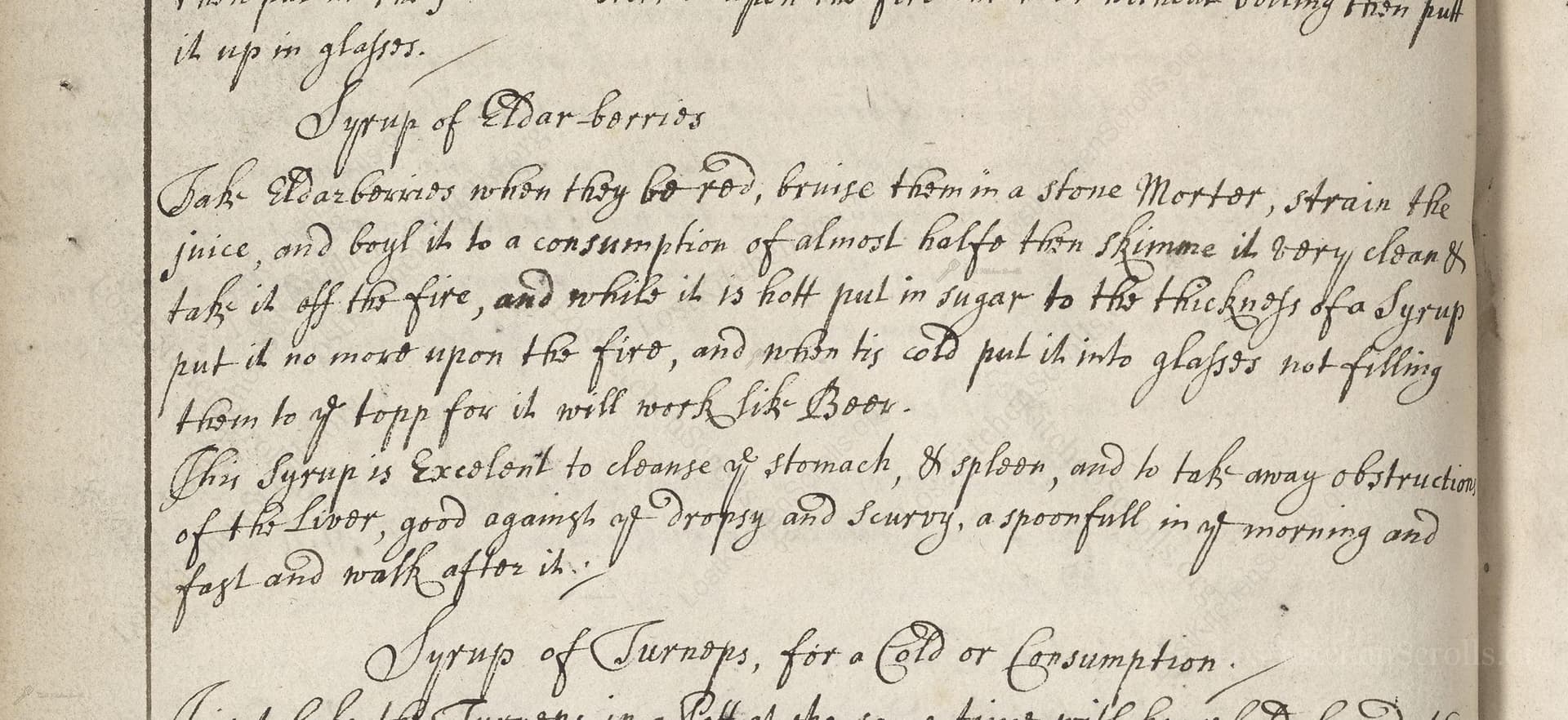Syrup Of Dar-Berries
From the treasured pages of Receipt book
Unknown Author

Syrup Of Dar-Berries
"Take Darberries when they be red, bruise them in a stone Mortor, strain the juice, and boyl it to a consumption of almost halfe then skimme it very clean & take it off the fire, and when it is hott put in sugar to the thicknesse of a syrup put it no more upon the fire, and when tis cold put it into glasses not filling them to ye topp for it will work like Beer. This Syrup is excelent to cleanse ye stomach, & spleen, and to take away obstructions of the liver, good against ye dropsy and scurvy, a spoonfull in ye morning and fast and walk after it."
Note on the Original Text
In the past, recipes were largely written as memoranda for those already familiar with kitchen processes, omitting precise measurements and assuming a degree of culinary intuition. Terms like 'to a consumption of almost halfe' tell you to reduce by about half, and 'boyl it' means simmer gently. Spellings are inconsistent—'boyl' for 'boil', 'ye' for 'the', and archaic medical language ('obstructions of the liver') is used casually. The use of capitalisation is haphazard and typical of manuscripts of the period.

Title
Receipt book (1687)
You can also click the book image above to peruse the original tome
Writer
Unknown
Era
1687
Publisher
Unknown
Background
A charming culinary manuscript from the late 17th century, brimming with recipes that blend hearty tradition and a dash of Restoration-era flair. Perfect for those seeking a taste of historic feasts and flavorful ingenuity.
Kindly made available by
Folger Shakespeare Library
This recipe hails from the late 17th century, found in an English household manuscript dated between 1679 and 1694. At that time, berry syrups were valued for both their culinary and medicinal properties, often taken as daily tonics to support digestion and ward off common ailments like scurvy—a real concern in a world before widespread citrus imports. Barberries themselves were prized for their tangy flavor and presumed capacity to "cleanse the stomach" and bolster the organs. This dual role, as both medicine and food, is typical of early modern kitchen wisdom, where the lines between apothecary and pantry were delightfully blurred.

The original cook would have used a heavy stone mortar and pestle for bruising and extracting juice from the berries. The mixture would then be strained through a cloth or a fine mesh strainer. For cooking, a brass or copper pan over an open fire or on the hearth was standard, with wooden or metal spoons for skimming and stirring. Glasses—likely simple glass bottles or jars—were used for storage, with space left at the top to accommodate fermentation.
Prep Time
15 mins
Cook Time
20 mins
Servings
8
We've done our best to adapt this historical recipe for modern kitchens, but some details may still need refinement. We warmly welcome feedback from fellow cooks and culinary historians — your insights support the entire community!
Ingredients
- 1 lb (about 18 oz) fresh barberries (or substitute with cranberries or redcurrants if barberries are unavailable)
- 1 1/2 cups (about 10.5 oz) granulated white sugar
Instructions
- Begin by sourcing darberries—this term likely refers to barberries, a tart red berry common to British hedgerows.
- Take around 1 lb (about 18 oz) of fresh, ripe barberries, wash them, and remove any stems.
- Using a sturdy mortar and pestle, crush the berries well to release their juice.
- Strain the pulp through a fine sieve or cheesecloth into a saucepan.
- Gently simmer the juice over low heat until it has reduced by about half in volume; this should concentrate both the flavor and the nutrients.
- Skim off any foam or impurities that rise to the surface during simmering.
- Remove the pot from the heat, and while the liquid is still hot, add granulated white sugar—approximately 1 1/2 cups (about 10.5 oz), or enough to create a thick syrupy consistency.
- Stir well to dissolve the sugar completely, but do not return it to the heat after adding sugar.
- Let the syrup cool, then pour it into sterilized glass jars or bottles, taking care not to fill them to the brim to account for potential fermentation (it may fizz like beer).
- Store in the refrigerator.
Estimated Calories
120 per serving
Cooking Estimates
You will need about 15 minutes to prepare the berries and the workspace, and around 20 minutes to cook and reduce the juice. Each serving contains about 120 calories. This recipe makes roughly 8 servings.
As noted above, we have made our best effort to translate and adapt this historical recipe for modern kitchens, taking into account ingredients nowadays, cooking techniques, measurements, and so on. However, historical recipes often contain assumptions that require interpretation.
We'd love for anyone to help improve these adaptations. Community contributions are highly welcome. If you have suggestions, corrections, or cooking tips based on your experience with this recipe, please share them below.
Join the Discussion
Rate This Recipe
Dietary Preference
Main Ingredients
Culinary Technique
Occasions

Den Bockfisch In Einer Fleisch Suppen Zu Kochen
This recipe hails from a German manuscript cookbook compiled in 1696, a time whe...

Die Grieß Nudlen Zumachen
This recipe comes from a rather mysterious manuscript cookbook, penned anonymous...

Ein Boudain
This recipe comes from an anonymous German-language manuscript cookbook from 169...

Ein Gesaltzen Citroni
This recipe, dating from 1696, comes from an extensive anonymous German cookbook...
Browse our complete collection of time-honored recipes



